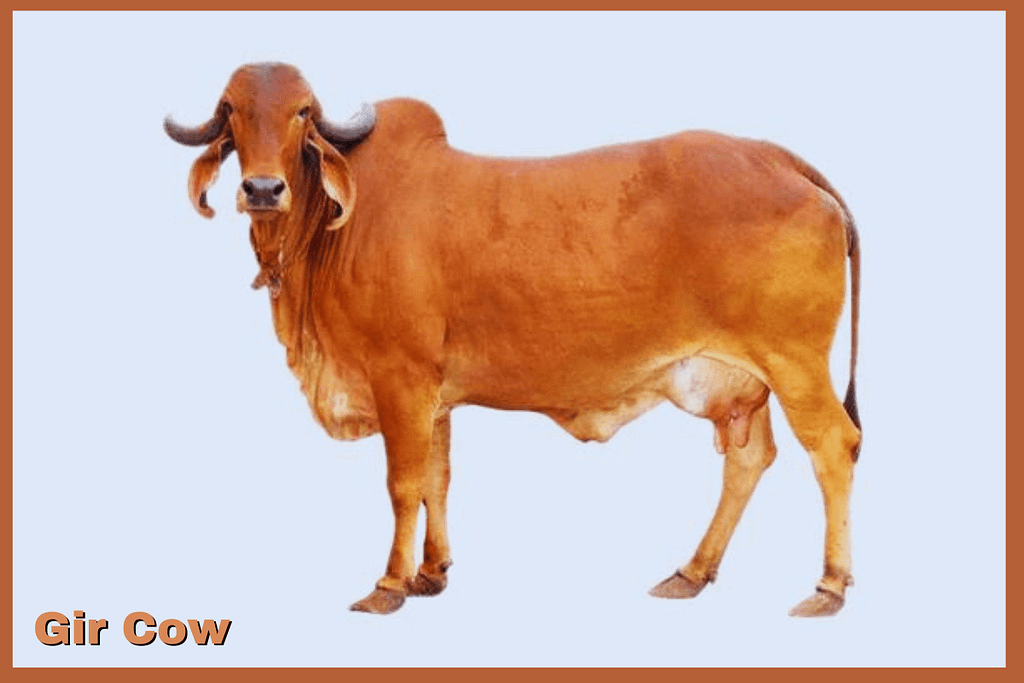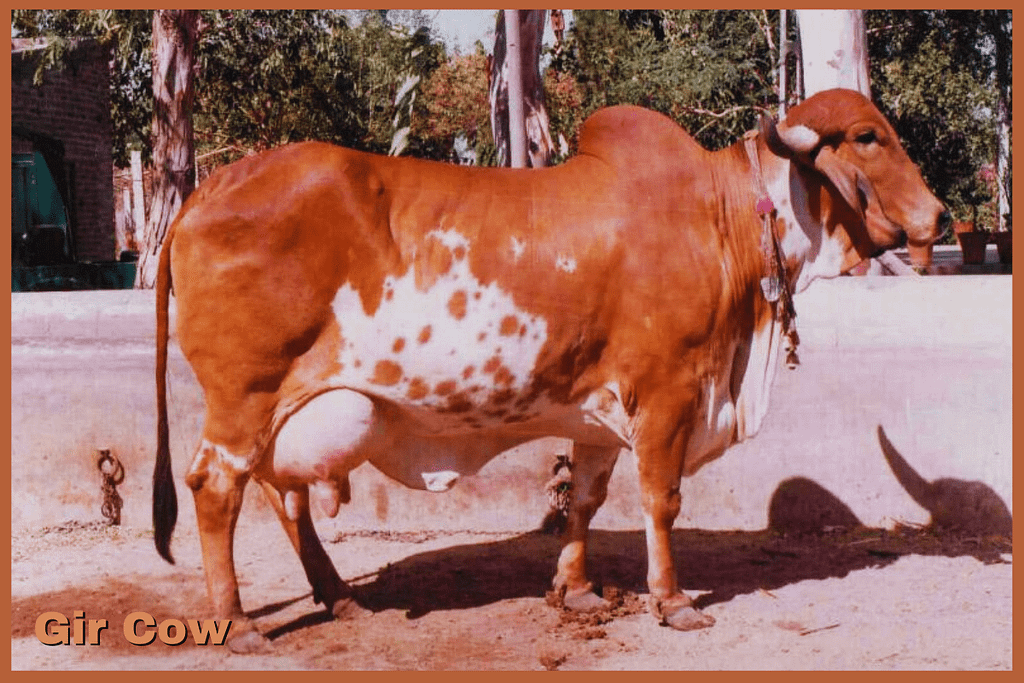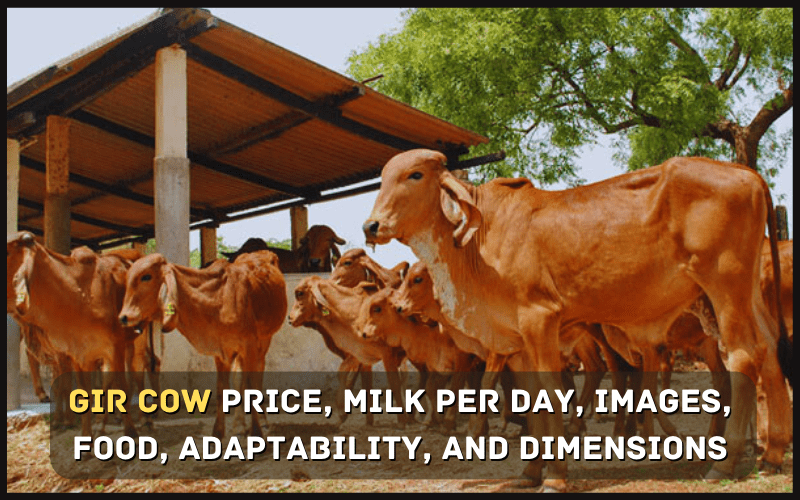Do you want to know everything about Gir cow? This article contains all you need to know, like how much they cost, how much milk they give each day, what they like to eat, how well they can adjust to different places, and how big they are. If you’re a farmer, a cow lover, or just curious, this article has all the info you need about Gir cow.
Nowadays, all over the World, especially in India, People are seeking detailed information about Gir Cow for their Popularity. The Reason Behind the Popularity of this Cow is giving a lot of milk, especially the healthy A2 kind, which is excellent for dairy farming. Gir cows can live in many different places and don’t need much attention from farmers. In India, people consider them unique and use them in religious events. People also want to keep their particular traits and make money from them. The internet has made learning about Gir cows easier, so more folks are curious about them.
In this article, we want to give you helpful information about Gir cows. We cover their cost, daily milk production, visual references, dietary preferences, adaptability, and physical size. This info is helpful if you’re a farmer, thinking about getting a Gir cow, or just interested in them. It can help you plan, know how much milk you’ll get, understand what they look like and eat, and how well they can live in different places. It’s good to have all this knowledge about Gir cows.
Read Also Punganur Cow Price, Daily Milk Yield, Life Span, Feed, and Size Discussed!
The Cultural Significance Of Gir Cows

In India, Gir cows are exceptional because of their cultural importance. In Hinduism, it is sacred and represents purity and god. It’s known as “Kamadhenu,” a cow that fulfills wishes. Gir cows are part of religious ceremonies, and their milk and dairy products are used in offerings and rituals.
This cow has also been important for many rural families, helping them in both their economy and society. Because of its cultural value, efforts are made to protect its particular genes. Gir cows are not just animals; they symbolize India’s culture and are deeply loved by its people.
Gir Cows In Their Natural Habitat
Gir cows, also called Gir Gaay or Gir Forest Cows, do well in the Gir Forest region of Gujarat, India. This place has dry and tropical forests, suitable for these tough cows. They can handle harsh conditions and eat grass, leaves, and shrubs. Having access to water from rivers and streams is essential for them.
Their presence in this area helps the environment by supporting many different plants and animals, and they help keep the forest healthy. The Gir Forest is like a safe place for these cows, which shows the strong connection between the region, the environment, and these special cows.
Related Content: Mini Highland Cow: Lifespan, Size, Weight, Price, Care Tips 2024
Gir Cow’s Food Preferences
Gir cows are famous for making a lot of milk and being able to live in different places. They eat specific foods to keep them healthy and ensure their milk is top-notch. They like to eat a mix of natural plants they find in their surroundings and extra food given by humans, and they always need enough water to stay healthy. Here’s a list of what Gir cows like to eat:
Grasses and Forage
They eat different grasses and plants from their surroundings. This natural food gives them essential nutrients for good milk.
Leaves and Shrubs
Besides grass, they munch on leaves and shrubs, which add more nutrients to their diet.
Crop Residues
Sometimes, they eat things left from farming, like crop leftovers. This helps, especially on farms, and is suitable for the environment.
Supplementary Feed
Sometimes, they get extra food to make more milk and stay healthy. This can include grains, pulses, oil cakes, and particular nutrients just for them.
Enough Water
Having clean water is essential for Gir cows. It helps them digest their food and make good milk. They like freshwater, which makes their milk better.
Gir Cows’Adaptability
Gir cows are known for being tough and can live in different places without problems. This makes them unique in the world of cattle farming. Let’s take a closer look at what makes Gir cows so good at adapting to different environments:
1. Tropical Climate Tolerance
Gir cows are well-suited to tropical and subtropical climates, thriving in regions characterized by high temperatures and humidity. Their unique physiological features enable them to cope with such conditions effectively.
2. Disease Resistance
These cows possess a robust immune system and genetic resilience, rendering them less susceptible to common cattle diseases. Their ability to resist infections contributes to their overall health and productivity.
3. Grazing Proficiency
Gir cows are exceptional foragers, adapting to a wide range of forage resources. Their adept grazing behavior allows them to utilize available natural vegetation efficiently, regardless of the habitat.
4. Habitat Diversity
Their adaptability extends to different habitats, from dense forests to open pastures and cultivated fields. Gir cows can thrive in natural and human-altered environments, showcasing their versatility.
5. Low Maintenance
Known for their low maintenance requirements, Gir cows primarily subsist on natural forage, reducing the need for costly supplementary feeding. This characteristic makes them economically viable for farmers.
6. Economic Viability
The adaptability of Gir cows, combined with their ability to produce high-quality milk, makes them a cost-effective choice for dairy farming, even in areas with limited resources.
Gir Cows And Their Impact on Agriculture

Gir cows are famous for making lots of milk and being able to live in different places. They have an extensive impact on farming in many ways. They help farms produce more sustainably and are culturally significant. Let’s see how Gir cows make farming better:
Milk Production
They make a lot of milk, which is good for local communities and the dairy industry.
Nutrient-Rich A2 Milk
Their milk is very healthy because it has A2 protein, which people like for its health benefits.
Natural Fertilizer
Gir cow dung and urine are used as natural fertilizers. This makes the soil better for farming and reduces the need for chemicals.
Adaptability
They can live in different places and eat from the land, which means less stress on crops and pastures.
Conservation of Indigenous Breeds
Keeping Gir cows helps protect different cattle breeds and keeps agriculture diverse.
Economic Livelihood
Gir cows are a source of income for farmers, especially those with small farms.
Cultural and Traditional Significance
They are essential in local customs and religious events, showing how they are part of farming and culture.
Gir Cows’ Physical Dimensions
Gir cows are unique because they look different from other cows. They have solid and graceful bodies with special features that make them essential in farming and dairy. Let’s look at what makes Gir cows physically unique:
1. Size and Weight
Gir cows exhibit medium to large-sized dimensions, with adult cows reaching 120-130 centimeters and weighing between 400 to 600 kilograms. Bulls tend to be larger, standing around 135-140 centimeters and weighing 800 to 1000 kilograms.
2. Body Structure
Their physique is characterized by a well-built and balanced frame featuring a deep chest, strong limbs, and a harmonious blend of strength and elegance.
3. Hump
The prominent hump on cows and bulls is a defining feature, serving as an energy reservoir for enduring harsh environmental conditions.
4. Horns
Gir cows typically have lyre-shaped horns that curve outward and backward, though variations exist in size and shape.
5. Skin Color
Their reddish-brown coat with distinctive white markings on the face, ears, legs, and underbelly is a hallmark of Gir cows.
6. Ears
Medium-sized and drooping ears add to their unique appearance.
7. Udder
A well-developed udder with moderately sized and well-placed teats is conducive to their exceptional milk production.
Gir Cows Pricing
Gir cows in India could cost anywhere from around ₹30,000 to ₹1,50,000 or even more. The price depends on the cow’s age, family history, how it looks, and how much people in the area want it. But remember, cow prices can change because of market stuff, how many cows there are, etc.
If you want to know the latest, best prices for Gir cows, it’s a good idea to talk to local cow sellers, people who know about farming, or visit cow markets near where you live. Prices might differ now, so getting the newest info is wise before buying a cow.
Gir Cow Milk Production
Gir cows are celebrated for their excellent milk production; their daily yield is usually measured in liters. A healthy Gir cow can produce anywhere from 12 to 20 liters of milk daily in a well-managed dairy setting.
Some exceptional individuals within this breed can even surpass these figures. This impressive milk production capability has made Gir cows one of India’s preferred choices for dairy farming.
Genetic Potential
Their genetic line can significantly influence the milk production potential of Gir cows. Cows from high-yielding genetic lines produce more milk than those with lesser-known pedigrees.
Diet and Nutrition
Proper nutrition plays a crucial role in maximizing milk production. Gir cows should receive a balanced diet that meets their nutritional requirements. Access to quality forage, supplementary feeds, and clean water supports high milk yields.
Lactation Period
Milk production peaks in the early stages of lactation and gradually declines over time. The duration of the lactation cycle, which typically lasts for about 300 to 305 days, influences the total milk yield per lactation.
Health and Management
Gir cows’ overall health and well-being and effective management practices are vital for sustaining high milk production. Proper healthcare, regular milking schedules, and comfortable living conditions contribute to milk output.
Disease Resistance
Gir cows are known for opposing certain diseases, which can help maintain consistent milk production throughout lactation.
Seasonal Variations
Milk production may vary with seasonal changes, with cows typically producing more milk during cooler and less stressful seasons and potentially less during extreme heat or other challenging weather conditions.
Selective Breeding
Many farmers focus on improving milk yield through selective breeding, aiming to propagate the genetics of cows that consistently produce higher quantities of milk.
Conclusion
Gir cows hold cultural significance in India, where they are revered as sacred animals in Hinduism. Their role in religious ceremonies and offerings underscores their deep-rooted connection to Indian culture and society.
This article discusses how Gir cows can do well in their home in the Gir Forest of Gujarat, India. It shows how they can handle harsh conditions, find food in the wild, and help keep the environment balanced.
We Have looked at what Gir cows like to eat, which includes natural plants, leaves, shrubs, and extra food. All of this helps them make a lot of milk. It also mentions that clean water is essential for keeping them healthy and making good milk.
Gir cows can live in many different places, from hot areas to different types of homes. They’re good at fighting off diseases, finding food, and making money from dairy farming. That’s why people like having them around.
How Gir cows are essential in farming. They help make a lot of milk, especially the healthy A2 kind. Their dung and urine are used to make the soil better for farming. They can live in different places and help protect particular cow breeds. Gir cows also help people make money and are part of essential customs and traditions.
The article discusses Gir cow prices and how much milk they can make. It’s essential for farmers and anyone who wants to know more about these fantastic cows.
Frequently Asked Questions
What is the price of 1 Gir cow in India?
The price of a Gir cow in India can vary significantly depending on various factors such as age, health, pedigree, and location. On average, you can expect to pay anywhere from 20,000 INR to 1,00,000 INR or more for a Gir cow.
What is the price of the original Gir cow in Gujarat?
In Gujarat, the home state of the Gir cow, the price may be relatively lower due to local availability. However, it can still vary depending on the specific characteristics and quality of the cow. Prices in Gujarat may range from 15,000 INR to 60,000 INR or more.
What is the difference between average cow milk and Gir Cow milk?
Gir cow milk stands out due to its A2 beta-casein type, more digestible, and higher fat content, resulting in a creamier, richer taste than regular cow milk.
Which cow gives the best quality milk?
The idea of “best quality milk” can vary based on your wants. Gir cows have creamy, rich milk, Holsteins make a lot of milk, and Jersey cows have milk with lots of butterfat. It depends on your preference.









